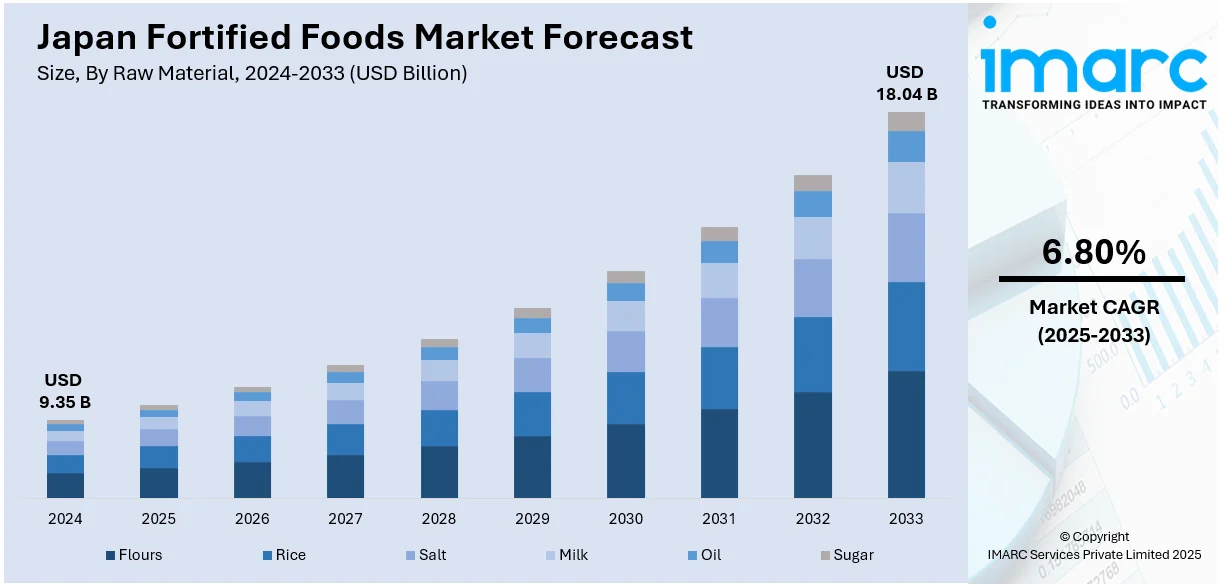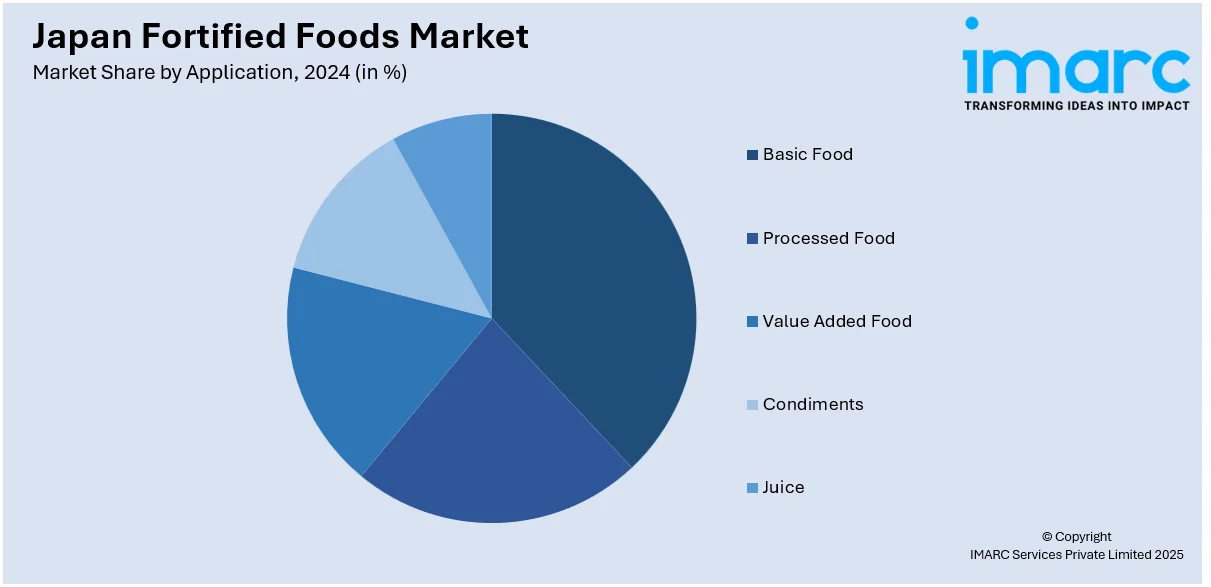
Japan Fortified Foods Market Size, Share, Trends and Forecast by Raw Material, Micronutrient, Application, Technology, Sales Channel, and Region, 2025-2033
Japan Fortified Foods Market Overview:
The Japan fortified foods market size reached USD 9.35 Billion in 2024. Looking forward, IMARC Group expects the market to reach USD 18.04 Billion by 2033, exhibiting a growth rate (CAGR) of 6.80% during 2025-2033. The market is driven by a rapidly aging population seeking nutritional support for healthy aging and rising adoption of digital health tools enabling personalized diets. These trends are catalyzing the demand for functional, easy-to-consume products aligned with individual wellness goals and health monitoring insights and contributing to the expansion of the Japan fortified foods market share.
|
Report Attribute
|
Key Statistics
|
|---|---|
|
Base Year
|
2024 |
|
Forecast Years
|
2025-2033
|
|
Historical Years
|
2019-2024
|
| Market Size in 2024 | USD 9.35 Billion |
| Market Forecast in 2033 | USD 18.04 Billion |
| Market Growth Rate 2025-2033 | 6.80% |
Japan Fortified Foods Market Trends:
Aging Population and Preventive Health Orientation
The growing geriatric population in the country, which require food products with added nutrients, is positively influencing the market. Recent government statistics in 2024, indicated that the senior citizen population has hit an unprecedented level of 36.25 million individuals. This demographic transition is highlighting the importance about healthy aging and nutrition-focused wellness, driving the need for food items that tackle age-related health issues. Fortified foods are emerging as an effective option for seniors aiming to preserve bone strength, heart health, and mental function without the challenges of juggling numerous supplements. Products enhanced with calcium, omega-3, vitamin B, and various functional nutrients are becoming more popular because of their convenience and numerous advantages. Older adults are particularly attracted to convenient or simple meal choices that facilitate living independently. Many people seek to control chronic illnesses, such as osteoporosis or hypertension, via their diet, making fortified items an appealing feature of their daily habits. Producers are creating formulations tailored for older adults, featuring nutrient-rich snacks, drinks, and meal substitutes. These items correspond with the cultural inclination towards food-oriented health options and indicate an expanding market niche centered on nutritional support for older adults. The rising senior population, along with increasing health consciousness, is supporting the Japan fortified foods market growth.

Influence of Technology and Personalized Nutrition
The growing use of digital health tools in Japan is reshaping how consumers approach nutrition, with fortified foods becoming an integral part of personalized dietary routines. The extensive use of wearables, health-monitoring applications, and genetic testing tools enables people to track essential metrics like heart rate, blood glucose, and sleep quality instantly. These instruments are shaping everyday food selections, steering individuals towards items that specifically align with their health profiles and wellness objectives. Fortified foods, providing specific advantages, such as stress relief, metabolic equilibrium, or immune enhancement, seamlessly align with this trend. The market for wearable medical devices in Japan hit USD 1.9 billion in 2024 and is expected to expand to USD 8.4 billion by 2033, indicating a strong CAGR of 16.7% from 2025 to 2033, as reported by IMARC Group. This increase indicates not only greater technology use but also a wider transformation towards preventive and data-driven lifestyles. Brands are adapting by providing clearly marked, functionally divided products that assist individuals in matching their nutritional consumption with immediate data from their devices. Whether it is energy-boosting drinks or snacks aimed at maintaining blood sugar balance, tech-savvy individuals are driving the demand for personalized nutrition. With a rising number of people relying on digital health insights for their eating habits, fortified foods are turning into vital components of personalized wellness approaches in Japan's changing environment.
Japan Fortified Foods Market Segmentation:
IMARC Group provides an analysis of the key trends in each segment of the market, along with forecasts at the country and regional levels for 2025-2033. Our report has categorized the market based on raw material, micronutrient, application, technology, and sales channel.
Raw Material Insights:
- Flours
- Rice Flour
- Wheat Flour
- Corn Flour
- Rice
- Salt
- Milk
- Oil
- Sugar
The report has provided a detailed breakup and analysis of the market based on the raw material. This includes flours (rice flour, wheat flour, and corn flour), rice, salt, milk, oil, and sugar.
Micronutrient Insights:
- Vitamins
- Vitamin A
- Vitamin B
- Vitamin C
- Vitamin D
- Others
- Minerals
- Calcium
- Iron
- Zinc
- Iodine
- Others
- Other Fortifying Nutrients
A detailed breakup and analysis of the market based on the micronutrient have also been provided in the report. This includes Vitamins (vitamin A, vitamin B, vitamin C, vitamin D, and others), minerals (calcium, iron, zinc, iodine, and others), and other fortifying nutrients.
Application Insights:

- Basic Food
- Cheese
- Butter
- Yogurt
- Others
- Processed Food
- Extruded Products
- Powdered Products
- Value Added Food
- Condiments
- Juice
A detailed breakup and analysis of the market based on the application have also been provided in the report. This includes basic food (cheese, butter, yogurt, and others), processed food (extruded products, and powdered products), value added food, condiments, and juice.
Technology Insights:
- Drying
- Oven Drying
- Drum Drying
- Spray Drying
- Extrusion
- Coating and Encapsulation
- Others
The report has provided a detailed breakup and analysis of the market based on the technology. This includes drying (oven drying, drum drying, and spray drying), extrusion, coating and encapsulation, and others.
Sales Channel Insights:
- Modern Trade
- Online Sales
- Neighborhood Stores
- Others
A detailed breakup and analysis of the market based on the sales channel have also been provided in the report. This includes modern trade, online sales, neighborhood stores, and others.
Regional Insights:
- Kanto Region
- Kansai/Kinki Region
- Central/ Chubu Region
- Kyushu-Okinawa Region
- Tohoku Region
- Chugoku Region
- Hokkaido Region
- Shikoku Region
The report has also provided a comprehensive analysis of all the major regional markets, which include Kanto Region, Kansai/Kinki Region, Central/ Chubu Region, Kyushu-Okinawa Region, Tohoku Region, Chugoku Region, Hokkaido Region, and Shikoku Region.
Competitive Landscape:
The market research report has also provided a comprehensive analysis of the competitive landscape. Competitive analysis such as market structure, key player positioning, top winning strategies, competitive dashboard, and company evaluation quadrant has been covered in the report. Also, detailed profiles of all major companies have been provided.
Japan Fortified Foods Market News:
- In April 2025, Japan enforced stricter regulations on dairy product fortification, especially involving probiotics and non-milk ingredients. Manufacturers must now submit detailed safety data and ingredient ratios for approval. The move aims to standardize fortified dairy products and ensure probiotic safety, particularly in infant formulas and functional beverages.
- In January 2025, Japan amended its Food Labelling Standards based on new dietary data, revising nutrient reference values and tightening rules for on-label claims. Fortified products must now disclose all fortification ingredients, aligning with global standards.
Japan Fortified Foods Market Report Coverage:
| Report Features | Details |
|---|---|
| Base Year of the Analysis | 2024 |
| Historical Period | 2019-2024 |
| Forecast Period | 2025-2033 |
| Units | Billion USD |
| Scope of the Report | Exploration of Historical Trends and Market Outlook, Industry Catalysts and Challenges, Segment-Wise Historical and Future Market Assessment:
|
| Raw Materials Covered |
|
| Micronutrients Covered |
|
| Applications Covered |
|
| Technologies Covered |
|
| Sales Channel Covered | Modern Trade, Online Sales, Neighborhood Stores, Others |
| Regions Covered | Kanto Region, Kansai/Kinki Region, Central/ Chubu Region, Kyushu-Okinawa Region, Tohoku Region, Chugoku Region, Hokkaido Region, Shikoku Region |
| Customization Scope | 10% Free Customization |
| Post-Sale Analyst Support | 10-12 Weeks |
| Delivery Format | PDF and Excel through Email (We can also provide the editable version of the report in PPT/Word format on special request) |
Key Questions Answered in This Report:
- How has the Japan fortified foods market performed so far and how will it perform in the coming years?
- What is the breakup of the Japan fortified foods market on the basis of raw material?
- What is the breakup of the Japan fortified foods market on the basis of micronutrient?
- What is the breakup of the Japan fortified foods market on the basis of application?
- What is the breakup of the Japan fortified foods market on the basis of technology?
- What is the breakup of the Japan fortified foods market on the basis of sales channel?
- What is the breakup of the Japan fortified foods market on the basis of region?
- What are the various stages in the value chain of the Japan fortified foods market?
- What are the key driving factors and challenges in the Japan fortified foods market?
- What is the structure of the Japan fortified foods market and who are the key players?
- What is the degree of competition in the Japan fortified foods market?
Key Benefits for Stakeholders:
- IMARC’s industry report offers a comprehensive quantitative analysis of various market segments, historical and current market trends, market forecasts, and dynamics of the Japan fortified foods market from 2019-2033.
- The research report provides the latest information on the market drivers, challenges, and opportunities in the Japan fortified foods market.
- Porter's five forces analysis assist stakeholders in assessing the impact of new entrants, competitive rivalry, supplier power, buyer power, and the threat of substitution. It helps stakeholders to analyze the level of competition within the Japan fortified foods industry and its attractiveness.
- Competitive landscape allows stakeholders to understand their competitive environment and provides an insight into the current positions of key players in the market.
Need more help?
- Speak to our experienced analysts for insights on the current market scenarios.
- Include additional segments and countries to customize the report as per your requirement.
- Gain an unparalleled competitive advantage in your domain by understanding how to utilize the report and positively impacting your operations and revenue.
- For further assistance, please connect with our analysts.
 Request Customization
Request Customization
 Speak to an Analyst
Speak to an Analyst
 Request Brochure
Request Brochure
 Inquire Before Buying
Inquire Before Buying




.webp)




.webp)












